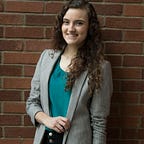The future of journalism: A bottom-up approach and a bird’s-eye view
On Day 1, #SuperJinNYC students learn about social and visual journalism from CUNY-J professors
In early May, 16 journalism students from the University of Oregon were prepared to take on the world. In high heels and blazers, we walked from our midtown hotel to the City University of New York (CUNY) Graduate School of Journalism.
This was the beginning of a week-long adventure in the media industry, but it felt like we were starting off right at home in a J-school. Although new to us, the classrooms and study spaces gave us a sense of familiarity in the unfamiliar world of New York City. This visit set the tone for the rest of the trip and opened our eyes to the possibilities of #LifeAsAJGrad.
First, we spoke with Dr. Carrie Brown, director of CUNY-J’s Social Journalism masters program, who lead a conversation on how journalists engage with community members.
Brown continually stressed the importance of building relationships with audiences.
She also invited two CUNY alumni, Max Resnik and Melissa DiPento, to share with us their projects in social journalism.
Later, we met Travis Fox, director of visual journalism, who showed us some pretty cool drone videography and told us a bit about issues surrounding drone use.
Here are three key takeaways from our conversations:
1. Bottom-up journalism can rebuild trust
“Social Journalism means putting the audience at the center of everything you do.” — Dr. Carrie Brown
With Dr. Brown, we discussed the idea that communities may be more likely to pay for news media and support journalists if they feel represented in their works. This insight was particularly interesting ahead of the rest of the week as we spoke with other media organizations facing the conflict of how to pay for quality journalism.
If certain demographic groups are feeling underrepresented in media, they feel no obligation to support that media.
According to Dr. Brown, rebuilding these relationships should help to rebuild trust among reporters and community members. Resnik, a Social-J alum, told us about his Listening Box community engagement project which he plans to take into laundromats, libraries and markets to hear from the community and practice “bottom-up” journalism by embedding reporters within the neighborhoods. The impact of this project will be one to watch.
2. The future looks (visually) awesome
Later, Travis Fox talked to us about the future of digital journalism. CUNY-J offered its first drone journalism course this past fall and Fox gave us a teaser for the class by briefing us on the legal and ethical questions of using drones in the name of journalism.
He gave us a few case studies, including an investigation on a meat packaging plant and the legality of flying over forest fires, all of which had us stumped and asking “how do we know what’s right?”
After having spent an hour discussing how to rebuild trust with Dr. Brown, Fox introduced a whole new world of potential distrust with the advent of small, video-enabled flying devices.
“People seem to have a fear of drones, but it’s more likely a fear of the unknown.” — Travis Fox
As for the future, Fox says to be prepared to get your drone pilot’s license. According to him, all local newsrooms will have drones, as they are relatively cheap and produce high quality visual journalism.
With the technology constantly changing, it is not unlikely to see more drone classes and see a heightened expectation of drone use for video and photojournalists in upcoming years. In fact, at the Agora Journalism Center, the School of Journalism and Communication campus in Portland, Oregon, drone journalism workshops are already being offered.
3. Into the world
Although we were still slightly jet-lagged and running on very little caffeine, we left CUNY feeling reinvigorated for the potential of social journalism and excited to see what the future holds for us young journalists.
We were prepared to take on whatever the world might throw at us, whether it be an internship at a local newspaper, graduate school in New York, or creating our own dream jobs that don’t yet exist.
Moving forward, our discussions at CUNY gave us confidence that we are on the right track at the UO, thanks to innovative curriculum and professors at the SOJC who have already begun teaching us these valuable lessons.
